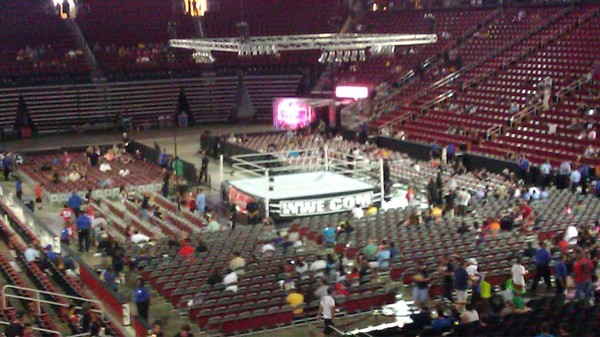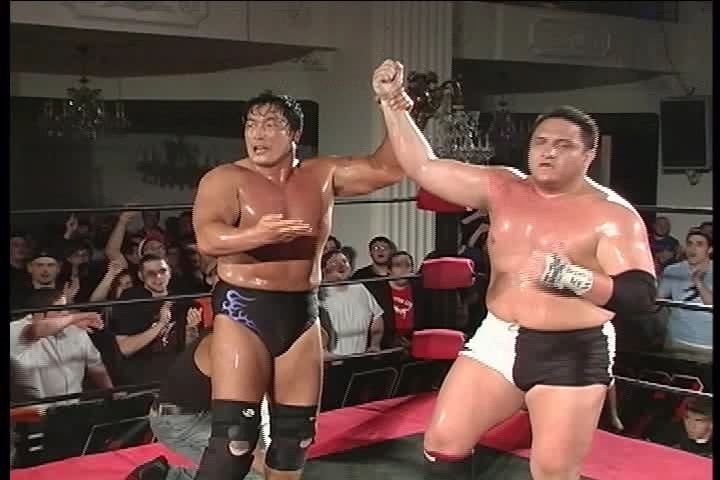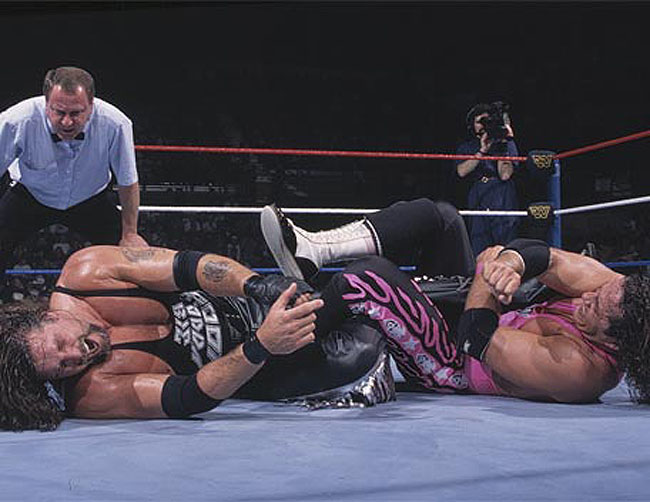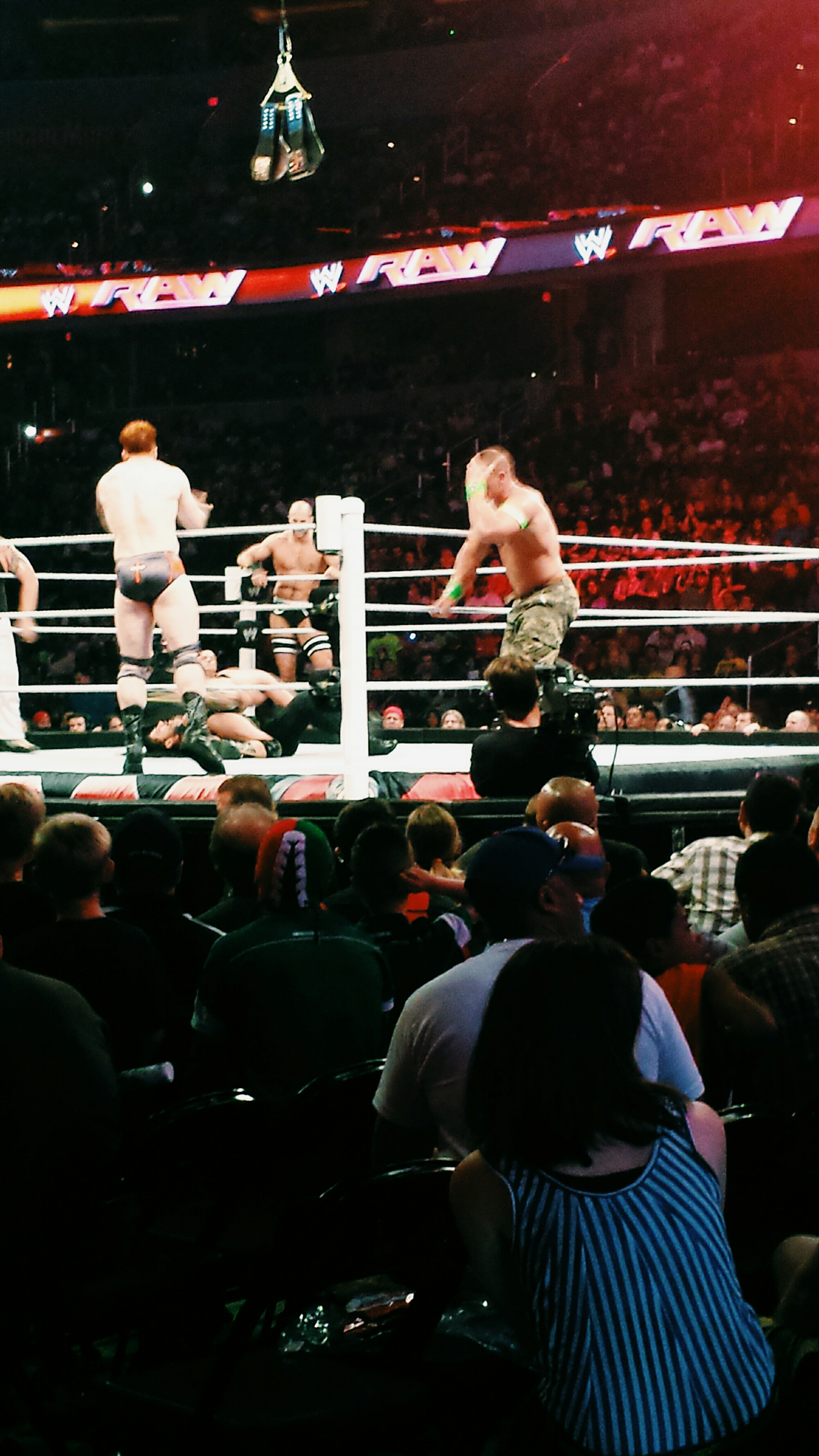Pro wrestling is a weird bastard art, and if you’re unfamiliar with its intricacies, the hordes of people in your social media circles obsessively pontificating about it every Monday night must be a truly confounding experience. Let our very own Dominic Griffin, lifelong wrestling enthusiast, teach you a little something right here, In This Very Ring…
As much as I love professional wrestling, I have never consistently been big on seeing it live. Oh, I LOVE live wrestling, of course, but living in the DC much of my life, without a strong indie fed nearby, it’s always been a manner of catching shows when they come through town and I’m just awful at planning things.
Since my youth, I have been to about four WWE events (two pay-per-views, a house show, and a Raw) five ROH shows (one in Philly, one in Jersey, two in Maryland and another in New York City), as well as two Platinum Championship Wrestling shows in Atlanta, both of which had one of my best friends on the card.
This Monday, I was lucky enough to tag along with another of my best friends (my tag team partner Kyle) to WWE Raw at the Verizon Center. It was a pretty fantastic show and we had some great seats. It reminded me that the disparity between watching wrestling live and in person versus at home on television is surprisingly vast.
Wrestling has long been a live performance art, but the last few decades’ increased focus on television product has created a bifurcated take on how to engage the crowd. On television, with multiple camera angles and editing techniques, the audience is transported from different points of view around the ring, the backstage area, vignettes filmed elsewhere and moments from episodes past. At a live event, the audience has a fixed point of view, so everything that happens in the show, on some level, has to connect with every single one of those points of view without the luxury of cutting away. What makes the WWE’s model so impressive is they manage to do both simultaneously.

WWE live in Houston. (Source)
If you’ve ever seen a filmed version of a play or a musical, you understand what a broken art it is. The performers are all playing to their live audience and someone with a camera is pan and scanning, trying to capture the proceedings into the ill-fitting confines of a television screen. Where WWE succeeds here is their approach. Everyone involved with the production is working towards both media. When I watch Raw at home, I love the little cinematic moments between wrestlers, little improvised facial reactions or things the wrestlers say to one another loudly enough for a mic to pick up. Being AT Raw, those moments (some of them anyway) can still be seen on the giant Titantron screen, which blows up and illuminates moments and action that may be out of your field of vision. It’s a nice balance.
Before Monday Night Raw starts, they usually tape a match or two for ancillary show Superstars. When you watch that show, it just feels like random matches featuring roster members who don’t often get much TV time on the prime show. When seeing these matches before Raw, they double as the “opening act,” perfectly warming the crowd up to the idea of three straight hours of wrestling.
This Monday, R Truth (who I just do not and never have liked) and his protégé Xavier Woods had a tag team match against RybAxel (the oddball team of monster Ryback and Curtis Axel, the son of legend Mr. Perfect Curt Hennig). Now, I did not give much of a shit when the entrances started, but at a live event, each of these performers played their role effectively, electrifying the crowd and getting them amped. Despite my best cynical efforts, I found myself super engrossed in the tropes of tag team wrestling that I’m usually a little numb to. It reminded me how much vaudeville is in the DNA of professional wrestling.
The entire show felt, from top to bottom, like watching a really big play, with various plot lines, cast members, and motifs effortlessly intermingling to create an engaging and entertaining show. The theatricality and the balancing act of it all was so much more impressive when you’re close enough to see these performers as real, live human beings, when you see the precision with which they move and the impact their bodies make with various tough surfaces.
The downside to seeing WWE live is just how large the enterprise is. Unless you’re at a scheduled meet and greet or a similar event, no matter how close you’re seated, there’s a palpable divide between the audience and the wrestlers. One of the things I always loved about going to Ring of Honor shows in their heyday was that feeling of intimacy. It’s the difference between seeing, say, Kings of Leon in an arena and seeing The Black Lips in a dive bar.
Years ago, probably around 2004, my friend Jon (now a wrestler himself) and I saw an ROH show. We had gone on a bus trip to Pennsylvania with a bunch of other like-minded geeks. The guy who organized the trip had a lot of friends in the business, so he was able to get a big ROH guy to come on the bus with us for a Q&A. It was CM Punk. Being not even out of high school, disillusioned with WWE, and entering my “early, contrarian hipster” phase, seeing CM Punk in person was insane. Jon was straight edge (at the time) solely because of seeing Punk promos. This dude was our God. I don’t remember many of his answers, but it stuck with me how cool and friendly he was.

Kenta Kobashi raises Samoa Joe’s hand after literally beating the shit out of him. (Source)
A year or two later, Jon and I trekked to NYC for ROH’s Joe vs Kobashi show. We waited in line for a couple of hours, trying to get general admission tickets. (Yes, we drove to New York not knowing if we would get in.) Samoa Joe, at this time probably one of the best in the world and one of my personal favorites, walked down the line chatting with fans and keeping them company to pass the time. At my first ROH show two years earlier, Joe was their champ (at the beginning of a historic run) and won me over completely, the first time I ever saw him. To this day, he is who I picture when I hear the phrase “world champion,” tough, heroic, all class.
Your relationship with wrestling changes as you grow older. At 17, I nearly creamed my jeans meeting CM Punk. At 27, I thought I was going to throat chop some hipster assholes for chanting his name at a show as he walked out. A big part of this is the crowd. When you’re in your teens, you’re surrounded by snarky, cynical fans who hate what’s popular and are more interested in getting themselves over with clever chants than they are with being spectators.
These are the same fuckheads who criticize women at wrestling shows for not being “real fans” and dissect everything they do as being evidence of some pernicious brand of dishonesty. Monday night, in our row, there were a few women sitting together who seemed bored most of the show. I found myself thinking, “why are they here?” like a complete asshole, and right when I did, it was the end of the Seth Rollins/Rob Van Dam match. Rollins was about to win when something happened and these women lost their fucking minds! I didn’t have a good view, but Dean Ambrose had interfered. Here’s the video (bonus backstage interview of Dean being Dean):
I cannot overstate how over Dean was with the crowd as a whole, but these women in particular. The last time I saw a reaction that strong it was when Beyoncé dropped an album after an episode of Scandal. It reminded me of the Joe vs Kobashi show. I sat next to a very sweet, very quiet young Japanese girl the whole show. She golf clapped respectfully at the end of matches, but seemed otherwise unengaged. I didn’t think much of it at the time, other than the same “man, why is she even here?” Then Kenta Kobashi came out. One of the most important wrestlers in history walked by to my right and when I turned back to my left, this girl was ON TOP OF HER CHAIR, BOUNCING UP AND DOWN, WAVING A GIANT HANDMADE BANNER, SCREECHING KOBASHI’S NAME FROM HER LIPS! Where was she hiding the banner? How was she effortlessly maintaining her balance while ecstatically showing so much love? Why was I such an asshole to assume she needed to do something like this to prove her mettle? Wrestling is for everyone. There’s something for every fan and it’s not up to you to police anyone for what that thing they connect to is. It’s why I miss being a kid.
When you’re a kid, none of that matters. None of it.
I was so jealous Monday night of the sweet kids in their neon John Cena gear with their foam fingers, excitedly cheering for their hero. Every punch that landed on Cena’s face was a dagger in their little hearts, but you can tell how much fun they were having. Everyone who bitches about the “PG Era” is an asshole. I’d watch another twenty years of Cena if it meant these kids could have the joy of wrestling in their lives.
(Also, special shout out to the little boy two rows behind me who actually hated Cena but liked everything else I like, including, but not limited to: Cesaro uppercutting people, Dolph Ziggler being amazing, Luke Harper’s lariat, and Naomi’s butt. Never change, kid. You’re my hero.)
I thought back to my youth, seeing Survivor Series ’95. I remember being really, irrationally sad when Diesel dropped the world title to Bret Hart, despite also being a fan of Hart. Diesel had the title for a year and my little brain just thought he’d have it forever. Seeing him get rolled up in that small package while the ref counted to three was devastating. I miss that. The visceral connection to the performers completely unencumbered by internet rumors and cynicism.

Diesel and Bret Hart battling for the WWF title back in my youth. (Source)
Seeing the show live gave me some of that back. We spend our whole lives trying to recapture our youths, when we were so carefree. It was nice to see some kids give me a masterclass in not giving a fuck and just having a good time. I’ll keep them in mind the next time I want to cry about Dolph Ziggler not winning matches.
Follow @DeadshirtDotNet and @captain_fuck on Twitter where we’ll be available to answer any possible question you could have about wrestling.


